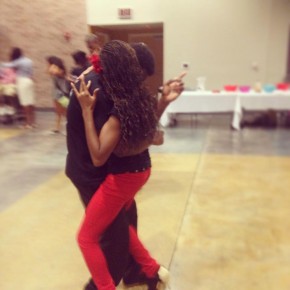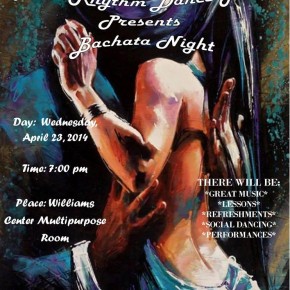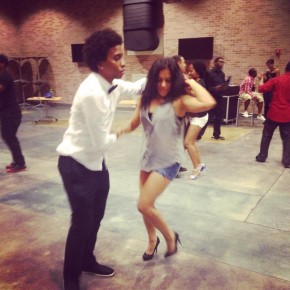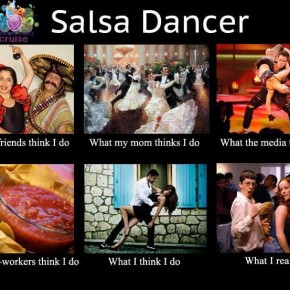Let’s Learn Latin Dance
In the beginning…
Bodies pressed tightly together, hips moving in synchronization, music fueling their bodies. This describes my mental image of Latin dance. I have been a dancer for many years but never have I done anything close to this style. I started in a ballet/tap class when I was five years old and stuck with it for 13 years. Over this time I have had the opportunity to learn many different types of dance, from hip hop to ballet, but there are many types that were not covered in my years of training. I never had the pleasure of learning Latin rhythm dance but it fortunately has been offered here at the school. I wanted to extend my knowledge of different styles of dance and observing the Latin Rhythm Dance Group here at Georgia Southern initiated my doing so.
At the beginning of this immersion, I was already a student at Georgia Southern University, and that put me in the position to be a part of this group. My prior experience in dance allowed me to know how to count music, how to move my body, what kinds of responsibilities come with being a dancer, and how it feels to be part of a group. I had no prior knowledge of the Latin dance style, other than what I have seen on T.V. My thoughts were that this ignorance could turn out to be a benefit or a hindrance depending on how the lessons went. I was somewhat hesitant about this dance style because the little amount of it that I had seen appeared to be quite risqué and I was not used to this kind of dancing. The types of dances that a Latin dance group performs are often very sensual, and many originated from brothels and areas of the like. This posed a definite problem on my part, because it caused me to have a bias.
What Do I Want To Do?
While I observed this group I put myself in several different positions. I first set myself up as an outsider with no information on the history of the style other than what I have read on the group’s Facebook page. I refrained from looking up any information of this for several weeks, until I watched the practices for a while. After I observed the group for a couple of weeks, I placed myself in the position of a beginner; learned the dances, and researched the different types of Latin dance and where they all originated from. By doing this, I was able to gain background information, such as where it originated and how it became popular in the United States. Finally, I took on the position of a somewhat intermediate learner. Being a GSU student helped me with this final step because it gives me access to the club. Therefore, it was possible for me to attend more meetings.
What Do I Want To Know
Coming into this as an outsider, I had no information on what type of people this group was composed of or what it was that they did. Was there an even ratio of men and women? I knew that this dance style called for a lot of partner work so this would be a big factor in the dances they teach and what they did in the dances. Another question I had was what races the people involved in this club were. When Georgia Southern had the club fair the Latin Rhythm Dance group had a table set up and from my observations, I saw that the majority of the people at the table were people of color. Being white, I felt that I would stand out, but once I started getting more involved with the group and attended more meetings, I realized that my race did not matter. I was not worried that being Caucasian would keep me from finding a place in the group, as they do not restrict their membership in any way. I had to see if that was a good representation of the group when I went to the first meeting. I was also curious to see if the members had any kind of dance experience before joining the LRDG like I did, or if they just joined it for fun. I was able to asses this group and really get a grasp on what they were doing by getting these observational questions out of the way. Doing so made it easier to understand the setting that I had set myself up in. Once this basic information was collected, I was able to really throw myself into this culture.
The second set of questions that I had planned to tackle were on a deeper level than just getting data from the group. From what I had seen of this style of dance at this point, it appeared to be very seductive. Dance partners get very close together and dance in a way that seems similar to grinding. I wanted to know how they get comfortable enough with each other to be able to dance like this. I also wondered about the members’ significant others. If any of these dancers had a boyfriend or a girlfriend, I was curious as to how they react to their partner dancing so close to someone else. Did the dancers spend time as a group to become more comfortable with each other or to create a community between themselves? Also, how did this style represent the Latin culture? How did the closeness of the dancers connect to the other types of Latin dances? How did it differ from other types of partner dances, like the waltz and swing dancing? Where did the steps come from to begin with? These were just the questions that I had in the beginning and developed more over my time observing the group.
Bachata, Salsa and Merengue
The Latin Rhythm Dance Group at GSU focused mainly on teaching Bachata, a style of Latin dance that originated in the Dominican Republic and is named after the Bachata guitar music. The songs that are generally used for Bachata are about love, sex and dating. The instrumentation for these are electronic and have an R&B feel to them. The dancer uses all eight beats of the song while dancing Bachata. One rule that I learned while sitting in and observing the group is that no thumbs are used in Bachata. The dancers are expected to just rest their partners’ hands in their own instead of gripping it. While performing this dance style, the dancer “moves side to side in a four-beat pattern: three steps to the side followed by a pause” (Hanson 1). During these steps is when the dancer moves their hips dramatically, usually in the opposite direction of the foot they are stepping with. This is known as the basic step. Even the basic step is a workout on the body, since the dancer’s hips are constantly moving. In Bachata, a dancer can either stay a respectable distance away from their partner or they can choose to come in close and dance with them intimately.
Merengue and Salsa are also taught occasionally in the class, though not nearly as often as Bachata. Merengue is also from the Dominican Republic and is recognized as the country’s official dance. It is relatively easy to learn, and the basic movements go to the front, back and side. Salsa originated in the Caribbean, and contains “a four-beat combination of two quick steps and a slow step with a tap” (Types 2). These styles vary in difficulty, but the basic steps as described here are not as difficult as one would think. These again are a workout both for the body and the mind. One has to remember when to do the steps and then they have to actually perform the steps.
All of these styles have a strong male lead as the base for the dance. I believe that this represents the patriarchal system that is in place in Latin America. In most places around the world, the male figure is often the one that makes the rules, the money and the decisions. Latin America is no different and this is apparent in their dance styles. Ethnomusicologist, Joanna Bosse describes a dance move that I feel symbolizes this male control very well. “Lin (the instructor) created a series of moves that culminated in the men leading their partners in a backwards dip, so the women, pelvis to pelvis with their partners, arched backwards and swept their hair along the floor” (Bosse 56). This stuck out to me because the women are depending on the men to hold them up and to make sure that they do not fall. They are their entire support system, and their lives are essentially in their hands. This one step summarizes what a patriarchal relationship is composed of, women depending on men for support and the men taking the lead. I have personally experienced this while dancing with the Latin Rhythm Dance Group. Many of the males that I danced with just put me where they believed I needed to be and I had almost no control over my own body.
First Impressions
My first night attending a Latin Rhythm Dance Group meeting in Room 2047 of the Russell Union was slightly terrifying. I had no clue what the people would be like, if I would be accepted, or if I would know anyone who was a member. Walking in I noticed that while there were many people of color, there were also some European Americans like myself. That fact began to put me at ease. Maybe I wouldn’t stick out as much as I thought I would. I then realized that there were many girls dancing by themselves. Looking around the room I saw that there was large difference between the number of females and the number of males in attendance. I had expected this from the beginning so I was not very surprised at this.
Being late to the meeting, I saw that the instruction had already begun. Sitting in a corner, I began to properly observe all of the going-ons and happenings that were occurring in the class. My eye was drawn to the person leading the group: Charles Wynn, the beginner class instructor. He walked up to me when they had a slight break and invited me to join in with the rest of the class, but I declined. I needed to focus on observing and taking notes for the moment. Once the social dancing started, Charles dragged me out into the open and led me through some awkward dance steps. He obviously was not fazed by anything, even my atrocious dancing skills. According to him, most people came to the meetings without any kind of prior training and I was doing a better job than most people on their first try.
An Insiders Opinion
I knew that I had to interview Charles Wynn the first time I met him, and the only way I had to get into contact with him was by tracking him down on Facebook. After a few minutes of searching, I found the man I was looking for and set up an interview for the next day.
We had arranged to meet at around 5:30 at Starbucks. I arrived about five minutes late, with no sign of Charles. I ordered my drink, and waited in the Russell Union for ten minutes. When there was still no sign, I texted him. He responded that he had gotten carried away dancing with some other members of the Latin Rhythm Dance Group and that he would be there shortly. When he arrived, he apologized once more and finally began the interview.
First, I got the basics. Charles Wynn is 22 years old and is double majoring in Electrical Engineering and Philosophy. He is an attractive African-American man, about 6’2″ who has no Latin heritage but still loves the dance styles and music. Charles has worked his way up to an instructor position in just a year, an accomplishment that seemed remarkable to me. I wondered if he had started out with training and talent, or if he had to practice very hard for the position.
“Well it’s actually been only six months. I just practiced all the time.” His hands began punctuating his words, “I was actually really, REALLY bad in the beginning, but also really enjoyed it so I stayed, and got better.”
Apparently, Charles practices Latin dance every day, outside of the group. He also travels to a Latin club in Savannah where he gets to dance with different partners that he is not used to. According to him, this is a good thing because then you can get used to dancing with people you are not familiar with and they could possibly teach you something that you have not learned before. He does not take any lessons from an older, more experienced teacher on a regular basis, and that shows that he is very passionate about Latin Dance because he works independently to improve his skills. Charles has been to a few Latin dance workshops, and will be attending one this year at the end of May.
“So,” I asked, trying to pump a story out of him, “what happens at these workshops? Are they just a one day thing, or are they weekend long convention-type affairs?”
He replied, “They are all weekend long. During the day, they hold classes of different types and the visitors are free to wander from class to class. At night there are performances from about 8:00 pm to 10:00 or 11:00. Then comes the fun part. After the performances, everyone dances all night.”
I assumed that “all night” would be from ten to about two or so. I was very wrong. According to Charles, the attendees dance from around ten at night until five or six in the morning. They literally dance ALL night.
I wondered how he got into all of this and why he was so passionate about it. His simple answer was that he saw the group at a club fair on campus, joined, and loved it. Outside of the Rotunda, the Latin Rhythm Dance Group was dancing for a club’s fair and the sight drew Charles in. He has been a part of it ever since.
I wondered out loud what his favorite parts of dancing and of being in the group were.
“I really love meeting new people. I never feel awkward in any situation so that makes it easy for me. With the group, my favorite part is the chemistry that everyone has with one another. We all have fun and are there because we enjoy it.” He answered this question with a smile on his face.
This opinion from Charles was not the first that I had experienced or read about. In his essay “Dance and Not Dance” Johannes Birringer states that “dance enjoys and reproduces a fairly clear sense of community” (Birringer 10) which I have seen multiple times. Wondering what could possibly hinder him in his love for Latin dance, I inquired as to if he had any difficulties learning or anything that made it harder for him to comprehend the moves.
“Two summers ago, in 2012, I was in a really bad car accident. I broke my femur and messed up my knee pretty badly. After I recovered I came back to Georgia Southern and found the group. What was hard for me was learning to adjust my weight and adapt to the moves. I still can’t put too much weight on that knee but it doesn’t stop me from dancing. I just learn to live with it and make certain alterations to the dance moves.”
I was amazed that he could still dance after being in such a bad accident, but also admired that it did not keep him from doing something he loved. I believed that it helped that he did not find the Latin Rhythm Dance Group until after the accident. That way he was able to learn the steps and the style without having to change the way he did it before. We soon wrapped up the interview. I learned that he mainly listens to Salsa and Bachata music and little else. He also participates in almost every event that the Latin Rhythm Dance Group holds for fundraisers or just to show off their skills. Finally he stated that he wants the group to be able to compete at a Latin dance competition, but does not think that they are up to those standards yet.
During my interview, I could see and hear how passionate he is about Latin dance. This made me want to get more into it and to try to get to his level of expertise, even though that may take quite a long time. When Charles left the interview, he was heading with some friends down to Savannah to practice his skills some more at a Latin club there.
Get Your Groove On
While Latin dance could be important to someone because they have connections to it through their heritage, or because they want to be accepted into a group that favors Latin dance, that is not true for everyone. Many take part in learning this style because of the benefits it provides. Dancing in general is great for the body, mind and spirit and Latin dance is no exception. It has become very popular among fitness classes and a variation of it has been adapted to form an exercise routine called Zumba. This is partially because of shows such as “Dancing with the Stars” and “So You Think You Can Dance.”
There has been quite a bit of research done on the physical and mental benefits of dance. The Mayo Clinic has found that social dancing reduces stress, increases one’s energy, gets a person in shape, and can also improve their coordination (Peritore 1). If there is a person looking for a fun way to lose weight and work on some cardio, then dancing is the right exercise for them. It also has mental benefits. Social dance can cause people to feel better about themselves and it can improve their memory, due to all of the movements and steps to the routine that they have to remember.
Latin dance is becoming a very popular way to exercise and lose weight because it is fun. When you are having fun while exercising, you tend not to notice the fact that you are indeed exercising. This is perfect for people who want a casual way to meet people and get into shape. I feel like this is especially important on college campuses because of the dreaded “freshman fifteen”. If there is a fun way to exercise and stay active, there will be many people wanting to participate and wanting to stay in shape.
A big part of any type of dance is being able to improvise and this is a great skill to have. Improvisation is defined as generating spontaneous movement in the moment (Legg 1). Many dancers start out at students and go on to become teachers. In order to come up with routines to teach any students that they may have, they need to be able to improvise. Being comfortable with this skill can help people be more comfortable with dancing in general. It enables them to let go of inhibitions and just relate what they are feeling through their movements. Improv can also help to decide what style of dance suits you best. With Latin dance, there are multiple clubs scattered around the nation and if someone visits one of these, they will notice people dancing all around. None of these people thought of a routine beforehand and informed their partner of this. They just go with the flow of the music and improvise. This is the key to being able to dance outside of a classroom.
Why Does This Matter?
The Latin dance group here at Georgia Southern is very open to people of all races, ages and backgrounds. There was never any awkward experiences due to my color, or the fact that I am only a freshman here. Many different kinds of people make up this group and not one of them are the same. No one would ever feel out of place here and that is what makes the Latin Rhythm Dance Group such a great thing. All they want to do is get together to socialize and dance because that is what the attendees love to do. I am so happy that I had the pleasure of being able to dance with them the few times I did this semester.
Even though this is mainly a social experience, there is a workout occurring. I always leave the meetings sweating. There is quite a bit of hip movement and you are constantly moving. The Latin Rhythm Dance Group gets me to exercise without me even noticing it, and I feel like for many college students, that is what we need. It also helps to train the mind because of all of the moves that are thrown at you. This group only has about an hour to teach you a dance so they tend to rush through it. Having to remember all the steps and what order they come in was consistently a challenge but the longer we went at it, the easier it was to remember the dances.
Though my time with the Latin Rhythm Dance Group was short, I quite enjoyed it. It was strange to be dancing so close to a member of the opposite sex that I was not in a relationship with, but luckily that did not occur at every meeting. I look forward to once again dancing with the group next semester, and hope that I can continue to improve my skills at that time. Observing this group made me more interested in other types of social dances and inspired me to take a ballroom dancing class next semester that I hope will include some Salsa dancing as well. My experience over these past few months has really opened me up to experiencing more things that are outside of my comfort zone, and I believe that this will make my time here at Georgia Southern just that much better.




